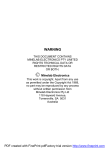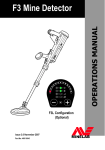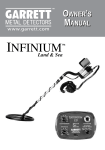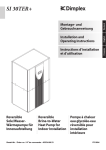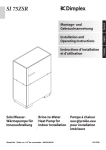Download Minelab Excalibur II Instruction manual
Transcript
Multiple Frequency Underwater Treasure Hunting Excalibur 800 Excalibur 1000 INSTRUCTION MANUAL The Minelab Excalibur with BBS Technology The Minelab Excalibur Instruction Manual Contents Page No. Introduction ................................................................................................ 3 BBS Technology ........................................................................................ 4 List of Parts ............................................................................................... 6 Accessories ............................................................................................... 6 Assembling the Excalibur .......................................................................... 8 Batteries ................................................................................................... 11 The Excalibur’s Controls ......................................................................... 12 Operating Instructions .............................................................................. 18 Treasure Hunting Tips .............................................................................. 20 Environmental Concerns .......................................................................... 23 Detector Care .......................................................................................... 24 Trouble-shooting Guide ............................................................................ 25 Specifications ........................................................................................... 26 Warranty and Service .............................................................................. 27 Minelab Service Repair Form .................................................................. 28 Version 1.1 August 2001 Instruction Manual Page 3 WARNING THIS DOCUMENT CONTAINS MINELAB ELECTRONICS PTY LIMITED RIGHTS TECHNICAL DATA OR RESTRICTED RIGHTS DATA OR BOTH. © Minelab Electronics Pty Limited This work is copyright. Apart from any use as permitted under the Copyright Act 1968, no part may be reproduced by any process without prior written permission from Minelab Electronics Pty Limited, 118 Hayward Avenue, Torrensville, SA 5031, Australia. Since there may be a range of options available in this detector type, equipment may vary according to the model or items ordered with your detector. Certain descriptions and illustrations may differ (in this manual) from the exact model that you purchased. In addition, Minelab reserve the right to respond to ongoing technical progress by introducing changes in design, equipment and technical features at any time. Page 4 The Minelab Excalibur Family Introduction Congratulations on purchasing one of Minelab’s new Excalibur detectors. The Excalibur 800 and Excalibur 1000 detectors have been designed specifically for underwater treasure hunting and are upgrades to the very successful Excalibur detector. Excalibur detectors use Minelab’s unique Broad Band Spectrum (BBS) technology, which enables them to transmit automatically at 17 individual frequencies at the same time. The benefits of multiple frequency technology are numerous and include increased depth, greater sensitivity to non-ferrous metal objects, increased accuracy in target indication, and increased stability under most conditions. The Excalibur is the highest performing and most reliable underwater discriminating detector available in the world today. It is designed to be used up to a depth of 200 feet, or when wading in shallow water, or on land. Excalibur detectors are designed to locate valuable metal objects in high trash areas and in areas of either extreme salt or ground mineralization, conditions that are commonly encountered by treasure hunters around the world. When using a single- or dual-frequency detector under these conditions, a treasure hunter may experience a significant loss of detection depth and discrimination accuracy. However, the Excalibur, with its 17 individual frequencies, eliminates the interference from these ground conditions and enables you to penetrate deeply and discriminate accurately at full depth. Excaliburs are easy to operate, having few controls that require adjustment after they have been set. The extremely advanced, yet easy-to-use discrimination features enable you to accurately select certain types of metals while rejecting unwanted objects. If you have any questions or comments regarding the Excalibur 800, the Excalibur 1000, or any other Minelab product, then please feel free to contact us via your local Authorized Minelab Dealer or write to us direct. We wish you every success in your treasure hunting. Instruction Manual Page 5 BBS Technology When developing BBS technology, Minelab’s engineers first looked at the technology that was already available on the market and identified its limitations in field use. Discussions with seasoned treasure hunters from around the world identified a number of common problems facing detector operators. These problems included: • Loss of detection depth in highly mineralized ground • Inaccurate target identification beyond 5 or 6 inches • Inability to detect good targets in close proximity to iron trash • Erratic operation when searching salt-water beaches. BBS circuitry allows the Excalibur to operate automatically at 17 different frequencies simultaneously — a feature that is unique to Minelab metal detectors. Most detectors on the market operate on a single (or dual) frequency, ranging from 1 to 70 kHz. Although this technology has served the industry well for years, Minelab’s engineers found that a frequency that worked well in one area would often offer only marginal performance when used in another location. Ground mineralization, trash content, and target size all had an effect on how well a detector transmitting a single frequency would operate. The BBS circuit automatically transmits 17 frequencies simultaneously, ranging from 1.5 to 25.5 kHz in 1.5 kHz increments. The signal received from the coil is analyzed and information is relayed to the operator via the headphones. Through the use of its 17 frequencies, the Excalibur is able to find and accurately identify targets at maximum depth, regardless of the ground conditions or trash present. Essentially, when using an Excalibur with BBS technology, it is like swinging 17 single-frequency detectors at the same time. Because BBS operates at a number of frequencies that no other detector does, BBS detectors such as the Excalibur can find objects that no other detector has the ability to find. Page 6 The Minelab Excalibur Family Figure 1 - Detector comparison chart The most important factor when comparing detectors with and without BBS circuitry is that BBS-based detectors have the ability to hunt in even the most mineralized areas at maximum performance without the need to groundbalance the detector manually. As soon as the Excalibur is turned on and swept across the ground, the ground mineralization is analyzed and then compensated for by the microprocessor. This ensures that the Excalibur can locate targets deeper than most other units currently on the market. One of the major overall benefits of BBS technology is that although it automatically operates at 17 frequencies — all at the same time — it is actually easier to use than most of its competitors. Because it is microprocessor controlled, all you need do is to set the threshold, discrimination, and volume, and the rest is done for you automatically. A BBS detector will penetrate more deeply, discriminate more accurately, and can be used in even the worst ground conditions. The bottom line is that when you use a Minelab detector such as the Excalibur with its BBS technology, you will find more good targets than you will with any other detector. Instruction Manual Page 7 List of Parts The box in which your Excalibur is shipped should contain the following items. When you first receive your Excalibur, please check that all these items are in the box: Part Excalibur model 800 1000 Electric Control Cylinder ! 8" Round BBS 800 coil (waterproof) or ! ! ! 10" Round BBS 1000 coil (waterproof) One-piece Upper Shaft Assembly ! ! (Long) Fiberglass Shaft ! ! Headphones ! ! Black Armrest ! ! NiCad Battery Pod ! ! Mains NiCad Charger ! ! Battery Adaptor Plug ! ! Warranty card ! ! Accessories In addition to the items supplied with your Excalibur, the following items are also available for you to purchase. • • • • • Hipmount bag 12V NiCad battery vehicle charger Short Fiberglass tube (for diving) Blue Minelab Cap Blue Minelab Poloshirt For more information on these and other Minelab products call your Minelab dealer. Page 8 The Minelab Excalibur Family Figure 2 - Excalibur exploded view Instruction Manual Page 9 Assembling the Excalibur Please follow these simple instructions to assemble your new Excalibur. Refer to the drawings to identify parts and how they are positioned. If you have any difficulties, call your dealer for more instructions. Armrest / Upper Shaft Assembly a) Remove the black nylon bolt and nut (2) from the armrest (1). b) With the armrest’s larger fins pointing in the same direction as the foam handgrip (4), slide the armrest (1) onto the end of the upper metal shaft (3). c) Push the nylon bolt (2) through the holes and tighten the wing-nut by hand. d) The control cylinder (5) and battery pod (6) should already be clipped onto the upper shaft. If not, then first clip the control cylinder onto the shaft. Ensure that the headphone cable (7) is pointing toward the armrest. e) Clip the battery pod onto the shaft, ensuring that the plug (8) is facing away from the armrest. f) Connect the battery cable from the control cylinder to the battery pod. The connection uses a water exclusion seal that needs to be firmly tightened by hand, otherwise water may enter the connection causing instability and corrosion of contacts, and voiding the warranty. Land and Wader’s Mode a) Remove the tape on the long fiberglass tube (9) that is holding the black teardrop washers (10) in place. NOTE: Make sure that the washers do not fall out after removing the tape. b) Remove the black nylon nut, washer, and bolt (11) from the coil (12). c) With the teardrop washers in place, push the lower tube assembly into the bracket on the coil so that the holes line up. NOTE: Ensure that the spring clip near the top of the fiberglass tube is pointing toward the rear of the coil. Page 10 The Minelab Excalibur Family d) Push the black nylon bolt (11) through the holes in the bracket on the coil from the cable entry side, then place the wing-nut on the other end of the bolt and tighten it by hand. Figure 3 - Excalibur with shaft assembled for Wader’s Mode Diver’s Mode Before setting up the detector for Diver’s Mode you will need to obtain the short fiberglass tube, which can be purchased as an accessory. a) Remove the tape on the short fiberglass tube (13) that is holding the black teardrop washers (10) in place. NOTE: Make sure that the washers do not fall out after removing the tape. b) Remove the black nylon nut, washer, and bolt (11) from the coil (12). c) With the teardrop washers in place, push the lower tube assembly into the bracket on the coil so that the holes line up. NOTE: Ensure that the spring clip near the top of the fiberglass tube is pointing toward the rear of the coil. Instruction Manual Page 11 d) Push the black nylon bolt (11) through the holes in the bracket on the coil from the cable entry side, then place the wing-nut on the other end of the bolt and tighten it by hand. Figure 4 - Excalibur with shaft assembled for Diver’s Mode Completing the Shaft Assembly a) Slide the lower shaft assembly into the upper metal shaft. Note that the black plastic twistlock nut (14) may need to be loosened to get the lower shaft assembly in place. b) Begin winding the coil cable firmly around the shaft by rotating the lower black stem. Wind between 25 and 28 turns of the cable until it reaches the control cylinder. c) Set the length of the shaft by locking the spring clip into one of the 3 holes provided, and then tighten the plastic locking ring by hand. NOTE: Leave enough slack at the bottom of the cable near the coil to adjust the coil position without straining the coil cable. Page 12 The Minelab Excalibur Family Batteries Excalibur detectors are all supplied with a battery pod which contains a rechargeable battery pack. Under most circumstances the battery pack can be used and recharged without ever removing it from the battery pod. Extra battery pods are available for purchase from your Minelab dealer and can be carried while detecting, thus ensuring that no loss of detecting time occurs if your battery goes flat. NOTE: Spare battery pods should not be taken underwater as they will discharge and the battery terminals will corrode. When the battery pod has reached the point at which it will no longer operate the Excalibur, threshold instability will occur and it is recommended that the battery pod be recharged or changed to avoid missing targets. Charging the Batteries a) To recharge the battery, unplug and remove the battery pod from the main shaft and connect it to the charger, using the supplied adaptor. b) Plug the charger into the power socket and leave charging for 12–14 hours. c) Before using your Excalibur for the first time, you should charge the battery for 12–14 hours in order to ensure peak performance in the field. d) It is not necessary to completely discharge or flatten the battery every time before recharging. However, we do recommend that this is done periodically to prolong battery life. e) A fully charged battery pod should provide you with 10–15 hours of detecting time. Instruction Manual Page 13 The Excalibur’s Controls This section gives detailed descriptions of the Excalibur’s controls and their functionality. It is important that you read through this section carefully as it will provide you with all the information required to set and adjust these controls. As you gain experience with your detector it may be beneficial to refer back to this section. Figure 5 – The Excalibur Control Panel Threshold Control and On / Off Switch The Threshold control allows you to adjust the level of background threshold in addition to switching the Excalibur “On” or “Off”. When in the fully anti-clockwise position, the Excalibur is “Off”. Turn the control clockwise and the Excalibur will “click” “On”. The background Threshold or “Hum” aids in the location of targets. Small or large, deep targets may not produce a distinct target signal but rather cause only a slight change in the Threshold tone. Ideally, this control should be set to a position where the Threshold tone is “just” audible. At this level, the presence of these small or deep targets will be more easily recognized. Turning the Threshold control in a clockwise direction, the Threshold level will increase. At the most clockwise setting, the Threshold is at its “maximum”. Once again, it is advisable to set this threshold to a level that is “just” audible. A Threshold level that is too high will “mask” out the small or deep targets, while a “silent” or non-audible Threshold level will not allow the small change in Threshold tone created by small or deep targets to be heard. Page 14 The Minelab Excalibur Family Volume Control This control is used to adjust a target’s signal volume. As you turn this control in a clockwise direction, the volume of target signals will increase. At the most clockwise position, the volume is set at the “maximum”, i.e. loudest, position. Sensitivity Control The Sensitivity control allows you to adjust the level of sensitivity to suit the ground conditions in which you are detecting. It is often thought of in terms of a depth control and it is, to a point, but it also makes the unit more or less sensitive to interference caused by such things as ground chemistry “mineralization”, or electrical fields. At the most anti-clockwise position this control “clicks” into the “Auto” position. In this setting the Excalibur will automatically select its optimum level of sensitivity to suit the conditions being worked. When detecting at the beach, set the Sensitivity to the “Auto” position when on wet sand, or concentrated black sand, or in the water. Turning the control clockwise will “click” the Excalibur out of the “Auto” setting into manual sensitivity. As you continue to turn this control in a clockwise direction the level of sensitivity will reduce. At the most clockwise position, the Excalibur is at “minimum” sensitivity. When not in the “Auto” position, the Sensitivity control should be set to the maximum manual position without registering interference from ground minerals or electrical interference. If ground minerals or electrical interference become too high, the Excalibur will produce a number of erratic signals. If this occurs, simply turn the Sensitivity control in a clockwise direction until these erratic signals disappear. Instruction Manual Page 15 Discriminate / Pin Point Mode Switch This switch selects either “Discriminate” or “Pin Point” mode. In “Discriminate” mode, the Discriminate (Disc) control becomes active. This control can be used to ignore various unwanted metal objects. Metal objects fall into two broad categories: ferrous and non-ferrous. A magnet can be used to determine if an object is a ferrous or non-ferrous metal; ferrous metals will be attracted to the magnet while nonferrous metals will not. Generally while detecting, ferrous objects such as iron and steel are not wanted, whereas the more valuable non-ferrous metals such as gold, silver, and bronze are wanted. In the “Discriminate” mode of operation and with the Disc control set to 1, the Excalibur will ignore or “mask out” ferrous metal objects while still accepting non-ferrous metal objects. In addition, target signals from non-ferrous objects will vary depending upon their level of conductivity. Effectively this allows you to identify the type of object detected before recovering it from the ground. By way of example, a US quarter or Australian $1 coin will produce a high pitch signal, whereas aluminum foil will produce a low pitch signal. Pull-tabs, rings, and certain coins will produce an intermediate pitch depending upon the object’s conductivity. The higher an object’s conductivity, the higher the signal tone will be. Additionally, in “Discriminate” mode, when the Excalibur detects a ferrous or rejected non-ferrous object, the background threshold tone will momentarily disappear and then return again at a pitch similar to the ignored signal. A ferrous object will cause the returning threshold pitch to be much lower than normal, while a pull-tab that is being ignored will cause the returning threshold pitch to be higher than normal. When in “Discriminate” mode, if the Excalibur produces a high-pitched rapidly pulsing sound, the detector is being overloaded by a substantially large piece of metal close to the coil. Raise the coil slightly above the ground and pass it over the area again to check the target. By lifting the coil away from the ground, it enables the Excalibur to analyze the object detected accurately. Page 16 The Minelab Excalibur Family In “Pin Point” mode, the Excalibur will detect both ferrous and non-ferrous objects. In this mode the Disc control has no effect and the Excalibur will respond in the same way to all types of metal. This mode is ideal for target pinpointing as the target signal response is fast and sharp. “Pin Point” mode is also useful if you are searching for ferrous targets such as relics. Discriminate Control The Discriminate (Disc) control is used when operating in “Discriminate” mode to select which unwanted non-ferrous metal targets are to be “discriminated” or ignored. If the Disc control is set to the most anti-clockwise position, the Excalibur will not produce a “signal beep” from ferrous metals. (Large ferrous objects may produce short “pops” or “clicks”.) However, non-ferrous objects will give a “signal beep” or be “accepted”. Typical ferrous objects encountered by treasure hunters are nails, screws, washers, bits of wire, etc. These objects are generally not considered to be of value, so it is a distinct advantage to be able to ignore them while detecting. Objects that will cause the Excalibur to produce a “signal beep” will be nonferrous metals, including such items as aluminum foil, most jewelry, pull-tabs, coins, bottle tops, gold, silver, brass, etc. Not all of these non-ferrous objects are considered valuable. Therefore, by using the Disc control, the Excalibur can be adjusted to ignore some of the less valuable non-ferrous objects while still locating the more valuable targets. The Disc control is a one-turn pot with 17 graduations. As you turn the Disc control clockwise and increase the “discrimination” level, non-ferrous objects of lower conductivity will be ignored. The Excalibur uses the electrical conductivity of the object to determine the type of metal detected and, based upon the Disc control setting, will either ignore or accept the object. The most effective way to demonstrate this is to consider a number of objects, all of varying conductivity, placed in a line on the ground. As you move from left to right, the objects increase in conductivity. Instruction Manual Page 17 Figure 6 - Target conductivity As you turn the Disc control more clockwise, objects with greater conductivity will be ignored. Imagine if you turn the Disc control to approximately position 11 to ignore the pull-tab. (Pull-tabs are made from various metallic alloys, thus their conductivity can vary. Disc control positions for pull-tabs may therefore range between 11 and 15.) Making this adjustment will mean that all objects having a similar or lower conductivity than the pull-tab will be ignored while objects of higher conductivity are still accepted, as shown in Figure 7. Figure 7 - Discriminating targets based on conductivity Figure 8 shows some common objects and where the Disc control has to be set to ignore them. As a general rule, the two objects treasure hunters most commonly wish to ignore are aluminum foil and pull-tabs. As can be seen in Figure 8, these objects both cover a significant range on the Disc control. Setting the Disc control “high” to eliminate all unwanted items will cause you to ignore a large range of valuable items. We recommend that you only discriminate the most common trash items, accepting the occasional unwanted target. Page 18 The Minelab Excalibur Family Figure 8 - Discriminate control examples The Disc control setting must be relative to the types of objects that you wish to hunt for and the amount of trash that you are prepared to detect. For example, if you are hunting for fine white gold rings and set the Disc control to position 4, you will also find some types of aluminum foil. If you do not want to dig old bottle caps but do want to dig brass buttons and copper coins, the Disc control is set higher (approximately at number 13), but most fine white gold rings, foil, and some yellow gold rings will also be ignored. With experience, setting the Disc control will become second nature, and you will be able to skillfully set this control to ignore most targets you do not want. Instruction Manual Page 19 Operating Instructions Setting Up The Excalibur “Discriminate” Mode • Ensure that the battery is fully charged. • Set the Pin Point / Discriminate Mode switch to “Discriminate”. • Turn the Excalibur “On” by turning the Threshold control in a clockwise direction and then continue turning it until the tone becomes “just” audible. • Set the desired position of the Disc control. • Set the Sensitivity control to “Auto” or at the maximum manual setting without interference. You are now ready to hunt. “Pin Point” Mode • Ensure that the battery is fully charged. • Set the Pin Point / Discriminate Mode switch to “Pin Point”. • Turn the Excalibur “On” by turning the Threshold control in a clockwise direction and then continue turning it until the tone becomes “just” audible. • Set the Sensitivity control to “Auto” or at the maximum manual setting without interference. You are now ready to hunt. Page 20 The Minelab Excalibur Family Practicing the Controls We suggest you first take some time to become familiar with how your Excalibur responds to various metal objects. Gather a collection of different metal objects such as a rusted nail, pull-tab, brass button, aluminum foil, various coins, and some gold and silver jewelry. Take the unit outside, away from known electrical devices or metal objects and support the Excalibur so that objects can easily be moved past the coil. Ideally, sit it on a wooden table away from nails and hinges. Then remove all jewelry from your hands and wrists. Ensure that the Mode Switch is in “Discriminate”. Turn the Disc control to the most anti-clockwise position. Turn the Sensitivity control to “maximum”, the most anti-clockwise position without clicking into “Auto”. If excessive interference is encountered, turn the Sensitivity control clockwise until this disappears. One at a time, pass the test objects across the coil. The Excalibur should “beep” on the non-ferrous objects and ignore ferrous objects. Take note that as you pass the ferrous nail over the coil the threshold tone disappears. As the threshold tone returns it will have a lower than normal pitch, indicating the object ignored was ferrous. Passing different non-ferrous objects over the coil will produce different signal tones. Objects with high conductivity, such as silver or lead, will produce a high-pitched signal tone while objects with lower conductivity, such as aluminum foil, will produce a low-pitched signal tone. With experience you will be able to use the signal pitch from an object to accurately determine the type of object you have found before recovering it from the ground. Now turn the Disc control progressively clockwise in steps and pass the objects over the coil. Take note of when certain objects are rejected, this will enable you to more accurately discriminate these objects in the field. Turn the Disc control to the position where it ignores the pull-tab. Passing objects with lower conductivity (such as the aluminum foil) over the coil will not produce a signal. Take note of the threshold tone as it disappears and then returns. It should return at a slightly higher pitch than normal. This indicates that the Excalibur ignored a non-ferrous object. Instruction Manual Page 21 Treasure Hunting Tips The Excalibur will perform at its best when the BBS coil is kept close to the ground. If you are not yet an experienced operator, you should practice maintaining a constant coil height at the extremity of each swing; maintaining contact with the ground will make this easier. This is important as variation in coil height at the end of each swing can cause confusing sounds and will reduce detection depth. Figure 9 - Sweeping the coil NOTE: Each sweep of the coil should overlap the last one. This will ensure good ground coverage. Keeping the BBS coil in contact with the ground will increase detection depth and response to small objects. Page 22 The Minelab Excalibur Family Pinpointing with the Excalibur When the approximate location of the target has been determined, move the coil slowly over the target. The audio tone will increase in volume while moving towards the target and decrease in volume as you pass it. The tone will be loudest when the coil is directly over the target. Quite often the detector will be producing its maximum volume for a broad area over the target. This generally indicates that the target is near the surface or is quite large. It may also be beneficial to switch to “Pin Point” mode, because in this mode the Excalibur produces a fast, sharp response to targets. The open design of the BBS coil makes it easy to mark the ground directly about the target to aid its recovery. Figure 10 - Pinpointing the target with the Excalibur Instruction Manual Page 23 Digging the Object Once you have pinpointed the target, clear away the surface material and check again for the signal. If there is no signal then the target is amongst the surface material. In this case search the area until you have located the target. However, if the signal is still there, remove a few inches of soil or sand off the surface of the ground. If the target is not visible, sweep the coil over the hole again. The signal should still be there, so continue to dig. Take care how you dig because a swift blow to an object with a pick could deface a valuable coin or split a piece of gold in two. If the object is not clearly visible you may need to scan the soil that has been dug up, so be sure to pile the soil carefully while digging. There are two methods of scanning this soil. 1. Spread out the soil and then sweep the coil over it to locate the target. (Be sure that there is no object buried in the ground beneath the soil.) 2. Lay the coil on its side near the hole. Pick up a handful of soil from the pile and pass it across the coil. If there is no signal then place the soil in a second pile away from the first and grab another handful of soil. Continue this process until you receive a signal; the target is now in your hand. Sift through the soil until the object is located. Once the target has been recovered it is a good idea to run the detector over the hole again to make sure that there are no other targets to be found. When you have recovered all targets from the hole, remember to refill it. Once a target has been found, there is a high chance that more targets are close by, so it is advisable to search the surrounding area extremely carefully Once again, always remember to refill your holes. Page 24 The Minelab Excalibur Family Environmental Concerns It should be pointed out that treasure hunting with a metal detector is the most environmentally friendly way to recover coins, rings, and other treasure items. However, it is important to leave an area that you have searched in the same condition as you found it. All holes that have been dug must be properly refilled. Not only is it environmentally unacceptable to not fill in your holes, it is also very dangerous. There are special tools that enable you to recover targets easily from grassed areas without digging large holes. Take away and properly dispose of any junk that you find or produce, such as nails, tin cans, or flat batteries. Leaving an area “scarred” can result in action being taken to prevent the use of metal detectors, which spoils this fascinating hobby for others as well as you. Instruction Manual Page 25 Detector Care The Excalibur is a high-quality electronic instrument, finely engineered and packaged in a durable housing. Taking proper care of your detector is mostly common sense. Salt deposits, very fine sand, and grit will accumulate everywhere on the Excalibur and must be removed after each use for best performance. • Always thoroughly rinse your Excalibur with fresh water after each use. Disconnect the shafts, battery pod, and armrest, and flush out all salt and sand, especially in the battery terminals. Failure to do this could cause the shafts to stick together permanently. • Avoid rapid changes in temperature. Gradual warming and cooling will keep the internal atmosphere stable. Extreme temperature swings may cause a light condensation to appear on the cylinder walls for a short time. Wait for the condensation to disappear before using your Excalibur. • Visually check the lower end of both cylinders after entering the water. If any water droplets or condensation are visible inside your Excalibur, turn it off and remove it from the water immediately. Remove your batteries and contact your Minelab dealer immediately. • The headphones need only be rinsed off. If the Excalibur is used for diving, it is critical that the vent hole in each diaphragm be kept clean to allow ear equalization. • Never open or tamper with the sealed electronics and battery cylinders, as this will void the warranty. This was sealed and pressuretested at the factory. • Never subject your Excalibur to rough or abusive treatment. It is a sophisticated piece of equipment and must be treated with care. • Never leave your Excalibur in direct sunlight. When left in direct sunlight, the black search coil can reach temperatures in excess of 150°C, causing irreparable damage to your coil. • Never allow the cables to be jerked or snagged. Excessive tension could cause the watertight seals or cable to fail. When disconnecting batteries, always grip the plug body, never the cable. Page 26 • The Minelab Excalibur Family Always keep the spare battery pod above the water’s surface. Your spare battery pod is not designed to be carried under water. If it is submerged in salt water while disconnected, the battery will discharge and the contacts will corrode. Trouble-shooting Guide Fault Solution No Sound Check battery is charged Ensure battery pod is connected Ensure unit is turned “On” Erratic Noises Check battery charge and battery connections Reduce the sensitivity by turning clockwise Switch to the “Auto” position Check for sand or grit between coil cover and coil Check for overhead power lines and other sources of electrical interference No Target Response Ensure unit is turned “On” Check battery charge and battery connections In the unfortunate circumstance that you need to return your detector to Minelab for service, please fill out the Service Repair Form on page 28 and enclose it with the detector. Please supply as much detail as possible as this will assist our service engineers to rectify the fault quickly and efficiently. Instruction Manual Page 27 Specifications These specifications are subject to change without notice. Applications Coin, relic, treasure hunting inland, beach, shallow water, diving Length Wader Extended Wader Unextended 1220 mm 1040 mm Weight Control Box, Shaft and 8" Coil Control Box, Shaft and 10" Coil Battery Pod 1.83 Kg 2.05 Kg 0.31 Kg Batteries NiCad Battery Pack 12V, 600 mA/Hr Coil 8" Round “Double D” waterproof 10" Round “Double D” waterproof (Excalibur 800) (Excalibur 1000) Headphones Impedance 8Ω Transmission Broad Band Spectrum: Multiple Simultaneous Frequency Transmission 1.5, 3, 4.5, 6, 7.5, 9, … 25.5 kHz Ground Rejection Automatic Ground Tracking Search Modes Pin Point: Discriminate: Controls Volume Sensitivity Auto or Manual Threshold / On Off Discriminate Pin Point / Discriminate Warranty Patents detects ferrous and non-ferrous metals rejects unwanted items Pot. 1 turn Pot. and Switch Pot. and Switch Pot. 1 turn Switch 2 Pos. 1 Year US 4942360, AUS593139, US4890064, US4894618, AUS595835, CAN1260146 Page 28 The Minelab Excalibur Family Warranty and Service There is a one-year parts and labour warranty for the electronic control box of the Excalibur. Refer to your Warranty Card for more details. The BBS coil is warranted for one year. Refer to your supplier or Minelab for service, either in or out of warranty. NOTE: This warranty is not transferable, nor is it valid unless the enclosed warranty registration card is returned to Minelab Electronics Pty Ltd or an authorized Minelab Electronics Pty Limited regional distributor within 14 days of the original date of purchase. The Minelab warranty does not cover damage caused by accident, misuse, neglect, alteration, modifications, or unauthorised service. For specific details of the Minelab warranty, refer to the machine’s “Product Warranty Card”. Instruction Manual Page 29 Minelab Service Repair Form Today’s Date: ........................................................... Detector Model: .............................................. Serial No.: ................................. Purchased From: ................................................................................................. Purchase Date: ......................................................... Faulty Part(s): ..................................................................................................... ............................................................................................................................ Description of Fault: ........................................................................................... ............................................................................................................................ ............................................................................................................................ ............................................................................................................................ ............................................................................................................................ Owner’s Name: ................................................................................................... Address: .............................................................................................................. ............................................................................................................................ Phone: Day ( Fax: ( ) ........................................ Home ( ) ............................... ) ....................................................... Email: ....................................





























